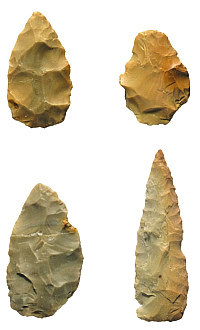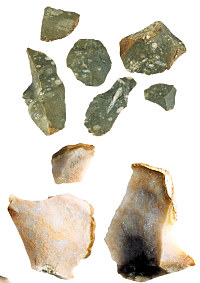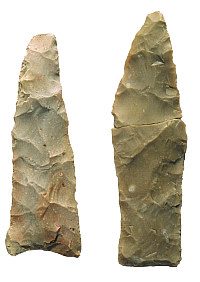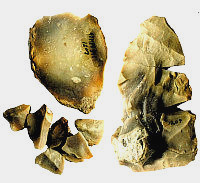|

|
The 10 stone debris piles were mapped across the Main Block based on matching debris of like color and texture. The piles range from 54 to 150 square feet in size and mostly were in single 4-inch levels. Graphic by Sandy Hannum. Click to see full image. |

|
Arrow point preforms recovered from the stone debris piles only roughly approximate the sizes and shapes of the finished arrow points also recovered. Most of the preforms were broken by hammer blows along the edges as they were being shaped. Click to see full image. |
 |
Color, texture, and inclusions were used to sort the stone debris within the debris piles. Like materials were considered to be from the same original cobble. Between 10 and 21 cobbles were recognized in each debris pile.
|
|
An unusual thing about the J. B. White site is that discrete piles of stone debris from making arrow points and knives remained intact within the site sediments. These debris piles consisted of the flint flakes and chunks that flintknappers (stone tool makers) generated as waste when they made tools. Also in these piles were broken, half-finished tools called preforms, and nearly finished tools. The archeologists found 10 such piles adjacent to some of the hearths. These artifact concentrations appear to represent activities that took place around the hearths. The flint (technically chert) in these piles started out as river cobbles gathered from nearby gravel beds along the Little River. The stone of the river cobbles is of good quality and was easily chipped to form the tools.
The knappers intentionally broke cobbles into large flakes that they could further work into arrow points. And they removed flakes of stone from both sides of some cobbles to make larger stone tools such as knives. The archeologists found broken arrow points and knives within the debris piles, along with fragments of arrow and knife preforms, cores, and expedient flake tools. Preforms are well-shaped, but unfinished, bifacial (two-sided) tools. Cores are the remains of cobbles from which multiple flakes have been removed. Expedient flake tools are simple flakes of stone whose sharp edges the Indians used for cutting and scraping. Flake tools are considered "expedient" because the knappers quickly made them as needed with little effort and just as quickly discarded them when the task at hand was completed.
The recovery of both expedient flake tools and the more "formally" (carefully and laboriously) shaped arrow points and knives provides direct evidence of the kinds of tool production that resulted in the debris piles. In fact, 39% of all the formal stone tools from the excavation blocks were found within debris piles. Likewise, 37% of all expedient tools were found amind debris piles.
One of the most pristine debris piles was near the top of Zone 2 where 706 chert flakes and chunks were found within a single unit-level (10-centimeter layer within a 1-meter square). The field crew knew that the sheer quantity of stone debris in this unit-level was unique, but it wasn’t until the laboratory crew washed the debris that they realized that these materials were probably made and deposited at more or less the same point in time. Most of this debris could be sorted easily into groups of light gray, brown, or yellowish brown chert. Groups of debris could also be separated out based on distinctive crystalline inclusions in the stone. The color, texture, and inclusions of the stone debris allowed researchers to trace the debris pile across six adjacent 1-meter squares.
Nine other unit-levels yielded some 300–500 pieces of debris each and were considered to represent the central areas of individual debris piles. The stone debris piles covered areas ranging from 5 to 14 square meters (54 to 150 square feet). This analysis revealed that the 10 debris piles were fairly intact and that they had not been jumbled or mixed with debris from earlier or later occupations.
When analyst Eloise Gadus matched like debris and cores, she found that each debris pile consisted of an average of at least 14 cobbles. The debris piles do not in themselves represent single stone tool making episodes. Rather, the large sizes of some of them, the likely presence of many more cobbles than the analyst could actually identify, and the mixture of various kinds of tool-making strategies represented by each pile indicate that they are the result of multiple episodes of tool manufacture, albeit ones that happened over limited time spans or within single occupational episodes.
Since the debris piles were fairly intact, it can be assumed that other concentrations of materials, such as animal bones and shells, that overlap or are adjacent to the piles are also fairly intact. This was a critical finding. As will be explained further in the next exhibit section, all of these concentrations represent activities that occurred near camp hearths. In this way, the stone debris piles provide some of the best evidence for the integrity of the campsite and for determining the kind of activities that took place around the camp.
Finally, the debris piles show what kinds of tools the knappers made. Arrow points and knives were most important. However, it is also clear that some tools that had already been in use were resharpened there in preparation for the next hunt. Also, these were places where people had struck expedient flake tools from cobble cores, used them, and then discarded them. These kinds of information help provide a picture of the patterns of daily life at the camp.

|
 |
Knife preforms recovered from the stone debris piles were often broken or displayed flaws within the chert that made continued shaping of the specimen fruitless. |
 |
|
From Cobbles to Tools... and Back Again
To confirm that stone debris was associated with a particular debris pile, analyst Eloise Gadus had to piece together like flakes and chunks to see what was broken apart and what was being made. This refitting of stone fragments is time consuming. Gadus did it by spreading out all the groups of like materials from each debris pile and trying to fit pieces of each group back together. This is like a three-dimensional puzzle that has half of its pieces missing. It requires the analyst not only to compare color, texture, and inclusions across multiple groups, but also to remember and compare shapes of pieces that might fit together. It is also helpful for the analyst to have a good idea of how chert breaks and how prehistoric knappers made tools. Still, refitting was the only way to prove that the debris piles represented separate knapping episodes. The number of refitted flakes per pile ranged from 0 to 69 with an average of 5 refits per pile. Pile 1 had the largest number of refits. This may be because that pile also produced the most cores and core fragments, and it was easier to refit larger chunky pieces such as cores than smaller flakes and chips. <<Read More>> |
|